Overview
The article titled "9 Key Differences Between Type 1 & Type 2 Diabetes Explained" compassionately explores the distinct characteristics that set these two types of diabetes apart. It delves into their causes, symptoms, treatment protocols, and risk factors, ensuring that readers feel informed and supported throughout their journey.
Type 1 diabetes is primarily an autoimmune condition, requiring lifelong insulin treatment. In contrast, type 2 diabetes is often linked to lifestyle factors and can initially be managed through dietary and exercise modifications. This highlights the importance of tailored management strategies for each type.
Remember, understanding these differences can empower you to take control of your health. You're not alone in this journey; we are here to support you every step of the way.
Introduction
Navigating the complexities of Type 2 and Type 3 diabetes can feel overwhelming for individuals and families. It's understandable to feel this way. T2DSolutions stands as a beacon of hope, providing a wealth of resources designed to empower you on your health journey. From actionable dietary plans to the latest insights from medical research, this platform is dedicated to equipping both newly diagnosed patients and healthcare providers with essential tools for effective diabetes management.
Particularly focused on the unique challenges faced by Hispanic and Latino communities, T2DSolutions collaborates with local organizations to enhance outreach and support. As the prevalence and financial burden of diabetes continue to rise, the need for comprehensive education and community support becomes increasingly clear. You're not alone in this journey; there are resources available to help you navigate these challenges.
This article explores the multifaceted aspects of diabetes, including:
- Causes
- Symptoms
- Treatment protocols
- The emotional impact of living with the condition
We aim to highlight the vital role of T2DSolutions in fostering informed and proactive diabetes care, reassuring you that support is always within reach.
T2DSolutions: Your Comprehensive Resource for Type 2 and Type 3 Diabetes Management
T2DSolutions offers a wide range of resources specifically designed for individuals, families, and healthcare providers managing type 1 & type 2 diabetes. As a brand new site, T2DSolutions is committed to creating and providing educational materials that include essential organizational strategies, dietary plans, exercise routines, and the latest insights from medical research. By emphasizing clear and actionable information, T2DSolutions empowers users to navigate their health journey effectively, equipping them with the essential tools needed for optimal well-being.
This commitment to education is particularly vital, especially considering that the incidence of diabetes among Hispanic and Latino adults varies from 5.0% to 7.3%. Customized educational materials are crucial for these communities to address their specific challenges in managing blood sugar. It's understandable to feel overwhelmed, but community-based organizations play an important role in education and prevention related to blood sugar conditions. T2DSolutions actively partners with these groups to enhance outreach and support for individuals affected.
The financial implications of diabetes are significant, with the total estimated cost of diagnosed diabetes in the U.S. for 2022 reaching a staggering $412.9 billion. This underscores the importance of efficient organizational resources. T2DSolutions collaborates with experts and advocacy groups to ensure the accuracy and relevance of its content, enhancing the credibility of the resources provided. This collaboration ultimately leads to improved health outcomes for users.
To maximize T2DSolutions' offerings, newly diagnosed patients are encouraged to explore the platform's comprehensive resources and engage with community support networks for a more effective management journey. You're not alone in this journey; we are here to support you every step of the way. Additionally, readers are invited to subscribe for updates as T2DSolutions continues to develop and expand its resources.
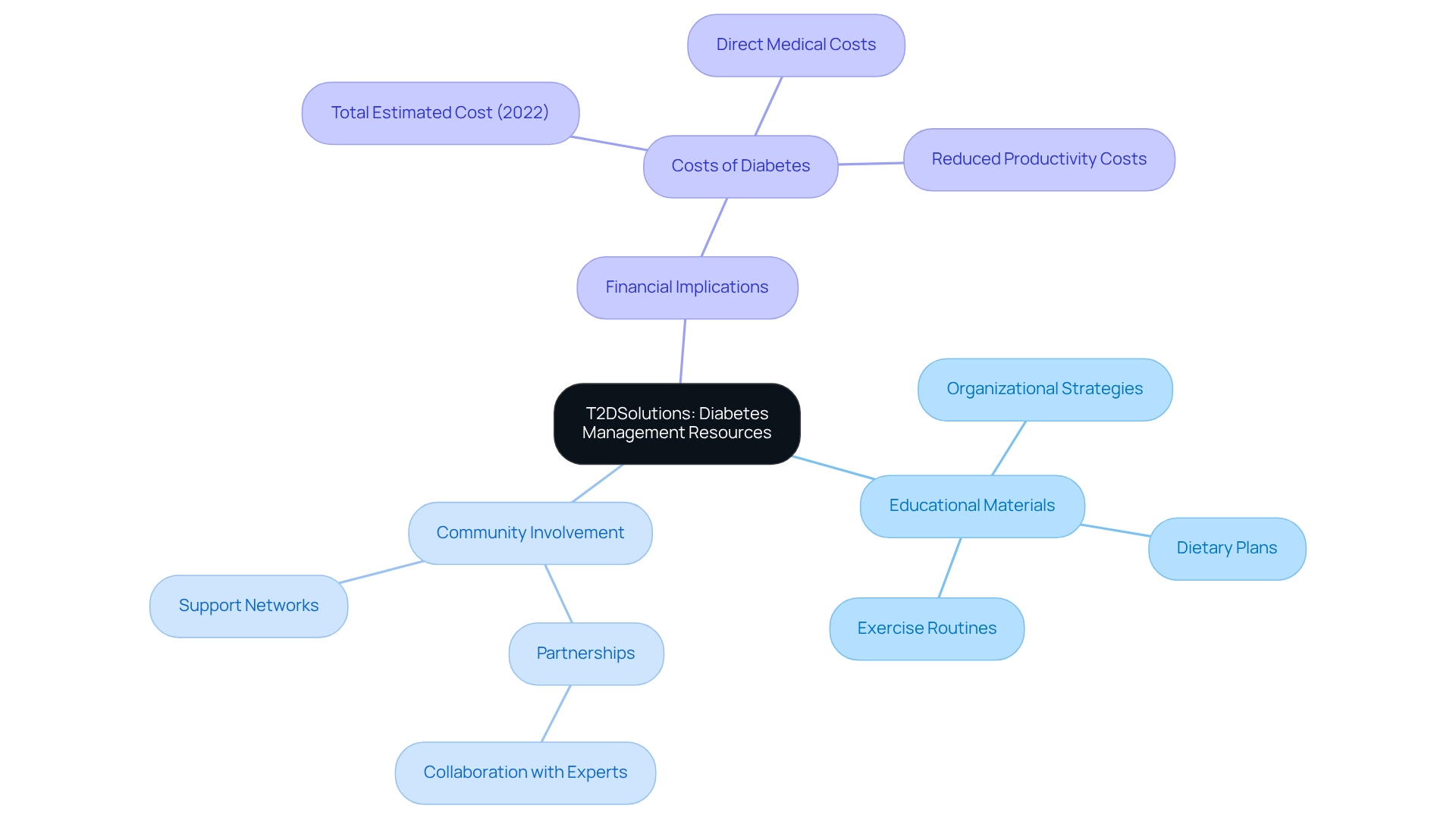
Cause of Onset: Autoimmune Response in Type 1 vs. Insulin Resistance in Type 2
Condition 1 is primarily triggered by an autoimmune reaction, which is a factor in type 1 & type 2 diabetes, where the body's immune system mistakenly attacks the insulin-producing beta cells in the pancreas. This leads to minimal or no insulin production. In contrast, the second form of the condition, known as type 2 diabetes, is characterized by insulin resistance, where the body's cells struggle to respond effectively to insulin, unlike type 1 diabetes. This often stems from factors such as obesity and a sedentary lifestyle.
Understanding these causes is essential for developing appropriate treatment strategies. At T2DSolutions, we recognize that navigating this journey can be challenging. That's why we are committed to providing newly diagnosed patients with extensive resources and support to help manage their condition effectively.
Our platform offers educational materials, community support, and actionable tips designed to empower you. Remember, you're not alone in this journey. We are here to support you every step of the way as you learn to understand and manage your condition better.

Symptoms: Distinct Manifestations of Type 1 and Type 2 Diabetes
Symptoms of type 1 & type 2 diabetes can appear suddenly, often leaving individuals feeling confused and concerned. Common signs of type 1 & type 2 diabetes include:
- Excessive thirst
- Frequent urination
- Intense hunger
- Fatigue
- Blurred vision
In contrast, symptoms of type 1 & type 2 diabetes develop more gradually. While they may present similar signs, type 1 & type 2 diabetes can also include:
- Slow-healing sores
- Frequent infections
- Areas of darkened skin
This gradual onset of type 1 & type 2 diabetes can lead to delays in diagnosis, making awareness crucial for your health.
It's understandable to feel overwhelmed by these statistics: around 3.4 million fatalities were linked to type 1 & type 2 diabetes, underscoring the importance of identifying symptoms promptly for timely medical intervention. The economic burden is significant too, with the total expense of diagnosed cases of type 1 & type 2 diabetes in the United States reaching $412.9 billion in 2022. This financial strain highlights the necessity of early identification of symptoms, as the typical medical costs for individuals with type 1 & type 2 diabetes are 2.6 times greater than those without.
As one saying fittingly expresses, "Living with T1D is a marathon, not a sprint," emphasizing the long-term care needed for Type 1. Understanding these symptoms of type 1 & type 2 diabetes not only aids in early detection but also underscores the need for proactive healthcare strategies. Remember, you're not alone in this journey. T2DSolutions serves as a vital resource center for newly diagnosed patients with type 1 & type 2 diabetes, offering education and support to help you navigate your health condition effectively.
Furthermore, the IDF Diabetes Atlas 11th edition, developed with support from prominent firms, provides valuable insights into managing type 1 & type 2 diabetes. We are here to support you every step of the way, encouraging you to seek out the resources and community that can make a difference in your journey.
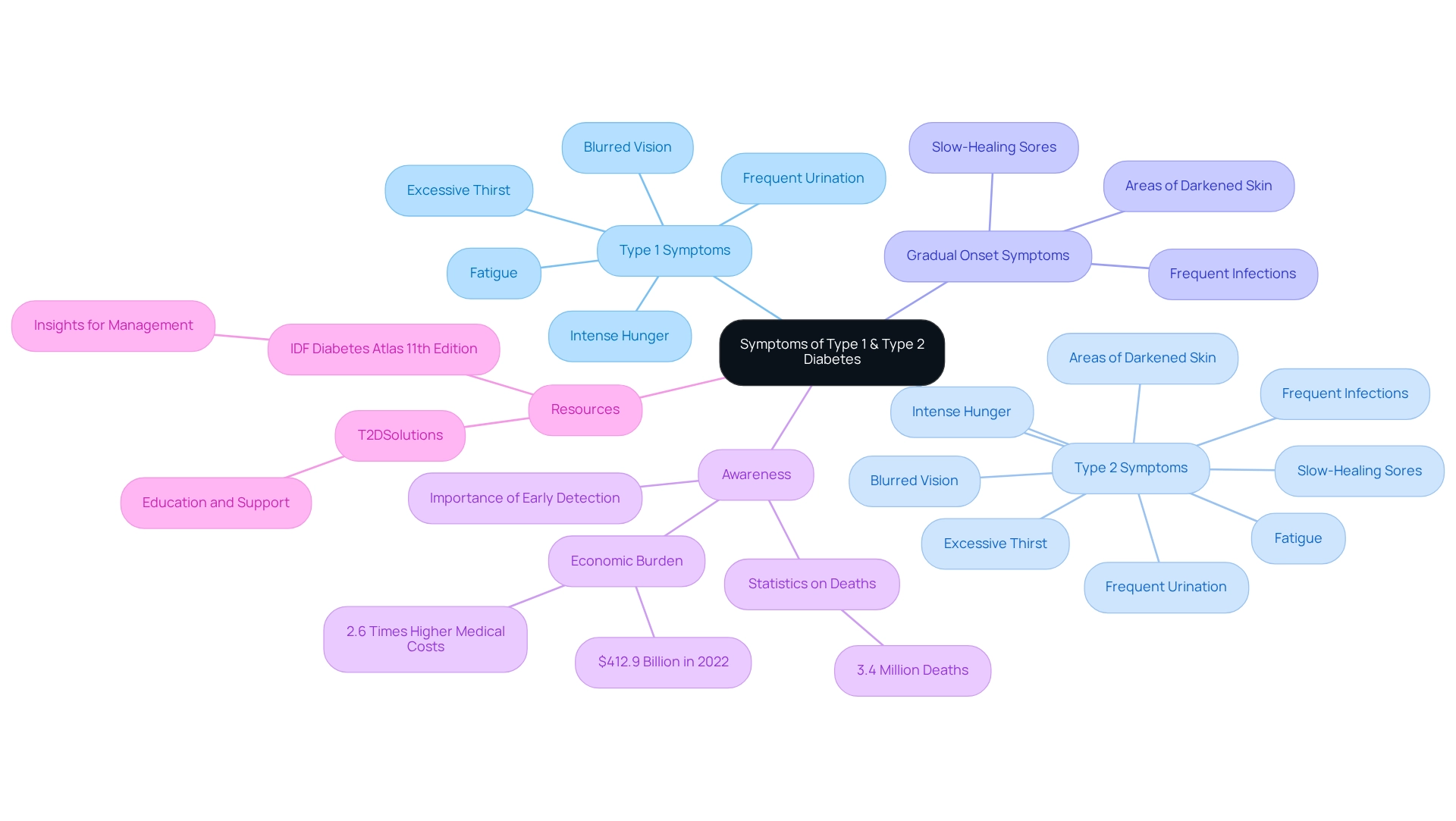
Treatment Protocols: Insulin Dependency in Type 1 vs. Lifestyle Modifications in Type 2
For individuals with conditions such as type 1 & type 2 diabetes, lifelong insulin treatment is essential for managing blood sugar levels, as their bodies are unable to produce insulin. This often involves multiple daily injections or the use of an insulin pump, which helps ensure consistent control over blood sugar.
In contrast, managing condition 2 typically starts with lifestyle changes. This may include adopting healthier eating habits, increasing physical activity, and focusing on weight control. While many people can effectively manage their condition through these adjustments, it's important to recognize that some may eventually need oral medications or insulin therapy as the disease progresses.
Recent studies indicate that nearly 30% of individuals facing blood sugar challenges due to type 1 & type 2 diabetes will require insulin therapy over time. This statistic underscores the importance of continuous monitoring and adjusting treatment plans, especially given the rising prevalence of conditions such as type 1 & type 2 diabetes linked to obesity and sedentary lifestyles.
Successful lifestyle modification programs have demonstrated that structured interventions can lead to significant improvements in blood sugar control. As highlighted in the case study "Understanding Diabetes Management," combining lifestyle changes with medical interventions creates a holistic approach. This not only empowers individuals but also fosters a supportive community where shared experiences contribute to better health outcomes.
As Peter M. House wisely stated, "Diabetes is not a burden, but a lesson in perseverance and self-care." Remember, you're not alone in this journey. We are here to support you every step of the way.
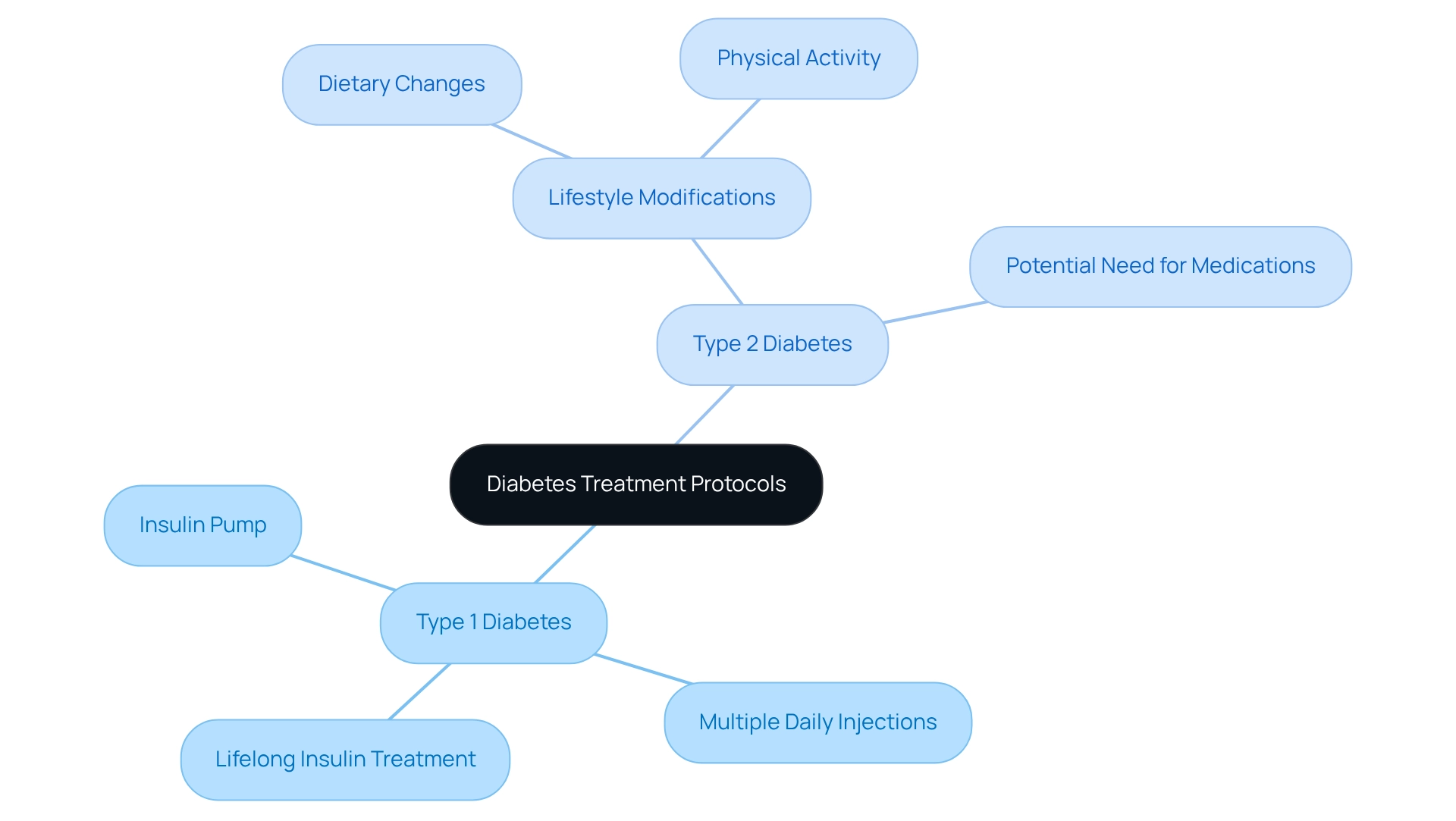
Risk Factors: Genetic and Environmental Influences on Type 1 and Type 2 Diabetes
Form 1 of type 1 & type 2 diabetes is significantly influenced by hereditary elements, with a family background serving as an important risk marker. It's understandable to feel concerned if you have a first-degree relative diagnosed with type 1 & type 2 diabetes, as research shows that this increases your risk of developing the condition. Additionally, environmental triggers, such as viral infections, may play a role in the onset, suggesting a complex interplay between genetics and external factors.
In contrast, type 1 & type 2 diabetes are primarily linked to different factors, with the second type being primarily associated with lifestyle-related risk factors, including obesity, lack of physical activity, and unhealthy eating habits. The prevalence of obesity has reached alarming levels, contributing to a substantial rise in type 1 & type 2 diabetes worldwide. Statistics indicate that around 252 million individuals are living with undiagnosed blood sugar issues. This highlights the essential need for regular screenings and proactive health measures to detect and manage the condition early.
Understanding these risk factors is crucial for taking proactive steps to lower your risk of developing the condition. For instance, participating in consistent exercise and embracing a balanced diet can significantly reduce your chances of developing a chronic condition. The National Diabetes Prevention Program offers lifestyle modification initiatives designed to reverse prediabetes, which can help prevent or postpone the onset of type 1 & type 2 diabetes. As Shamard Charles, MD, MPH, emphasizes, 'Prediabetes indicates that you have elevated blood sugar (glucose), but it's not high enough to be classified as type 1 & type 2 diabetes,' underscoring the importance of early intervention.
Research highlights the significance of both genetic and environmental factors in assessing the risk of this condition. A longitudinal study found that while the predictive power of clinical factors diminished over time, genetic factors remained stable, underscoring their critical role in long-term health risk evaluation. This understanding is essential for both individuals and healthcare providers, as it informs strategies for early intervention and personalized care. It can guide newly diagnosed patients in comprehending their risk and the importance of genetic factors in their personal wellness journey. Remember, you're not alone in this journey; we are here to support you every step of the way.

Emotional Impact: Coping with Type 1 and Type 2 Diabetes
Coping with this condition often brings significant emotional challenges, including anxiety, depression, and distress related to managing it. It's understandable to feel overwhelmed. Research suggests that while 44% of individuals with this condition feel capable of managing their health, many still express concerns about their overall well-being and lifestyle choices. This gap emphasizes the importance of education and support in managing blood sugar conditions, particularly type 1 & type 2 diabetes, which T2DSolutions seeks to offer as a complete resource hub. Individuals with insulin-dependent conditions, such as type 1 & type 2 diabetes, may face intensified feelings of isolation due to the ongoing requirement for insulin management, resulting in elevated stress and anxiety. On the other hand, individuals with type 1 & type 2 diabetes often encounter emotional challenges linked to lifestyle adjustments and the stigma connected to obesity, which can intensify feelings of inadequacy and distress. T2DSolutions provides resources and assistance to aid individuals in overcoming these difficulties.
Coping techniques are crucial for addressing the emotional effects of this condition. Engaging in regular physical activity, maintaining a balanced diet, and practicing mindfulness can significantly improve mental health outcomes. Furthermore, support systems like counseling and health support groups play an essential role in assisting individuals in managing these emotional challenges. T2DSolutions offers access to these networks, nurturing resilience and hope. Remember, managing this condition is a shared journey. As one quote reminds us, 'You're not alone—help is available!'
The emotional effect of this condition is progressively acknowledged in studies, highlighting the necessity for mental well-being assistance alongside conventional management of the illness. By addressing these emotional challenges, individuals can enhance their overall quality of life and improve their health outcomes. For ongoing support and resources, consider signing up for email updates from T2DSolutions to stay informed.

Complications: Long-term Health Risks of Type 1 vs. Type 2 Diabetes
Both type 1 & type 2 diabetes can lead to serious long-term complications, including:
- Cardiovascular disease
- Kidney damage
- Nerve damage
- Vision problems
It's important to note that the risk and onset of these complications can vary significantly between type 1 & type 2 diabetes. Individuals with insulin-dependent conditions often face issues at a younger age due to the earlier onset of the illness. In contrast, complications related to type 1 & type 2 diabetes typically develop more gradually, often influenced by lifestyle factors like diet and physical activity.
Statistics reveal that 8.0% of U.S. adults diagnosed with high blood sugar have a non-HDL cholesterol level of 190 mg/dL or greater, which poses a considerable risk for cardiovascular problems. This underscores the importance of monitoring cholesterol levels as part of blood sugar control. Additionally, research indicates that older age, male gender, urban living, and residing in the Southwest region are significant risk factors for macrovascular complications in individuals with Type 2.
A notable case study from 2020 reported 267,000 emergency department visits for hyperglycemic crises among adults with high blood sugar. This highlights the urgent need for enhanced care and education to prevent acute complications. Experts suggest that this condition may increase the occurrence of atrial fibrillation through associated risk factors, complicating the well-being of those affected. As Paraskevi Farmaki observes, "Diabetes mellitus probably promotes the incidence of atrial fibrillation through other risk factors that co-exist in these patients."
Regular monitoring and proactive oversight are essential for managing type 1 & type 2 diabetes to effectively mitigate these risks. By understanding the differences in complications and their onset, you can take informed steps toward better health outcomes. If you’re newly diagnosed, it’s recommended to engage in regular monitoring and consult healthcare providers for personalized care strategies. Remember, you’re not alone in this journey; T2DSolutions aims to be a valuable resource for you, providing educational materials and support to help you navigate your condition management journey.
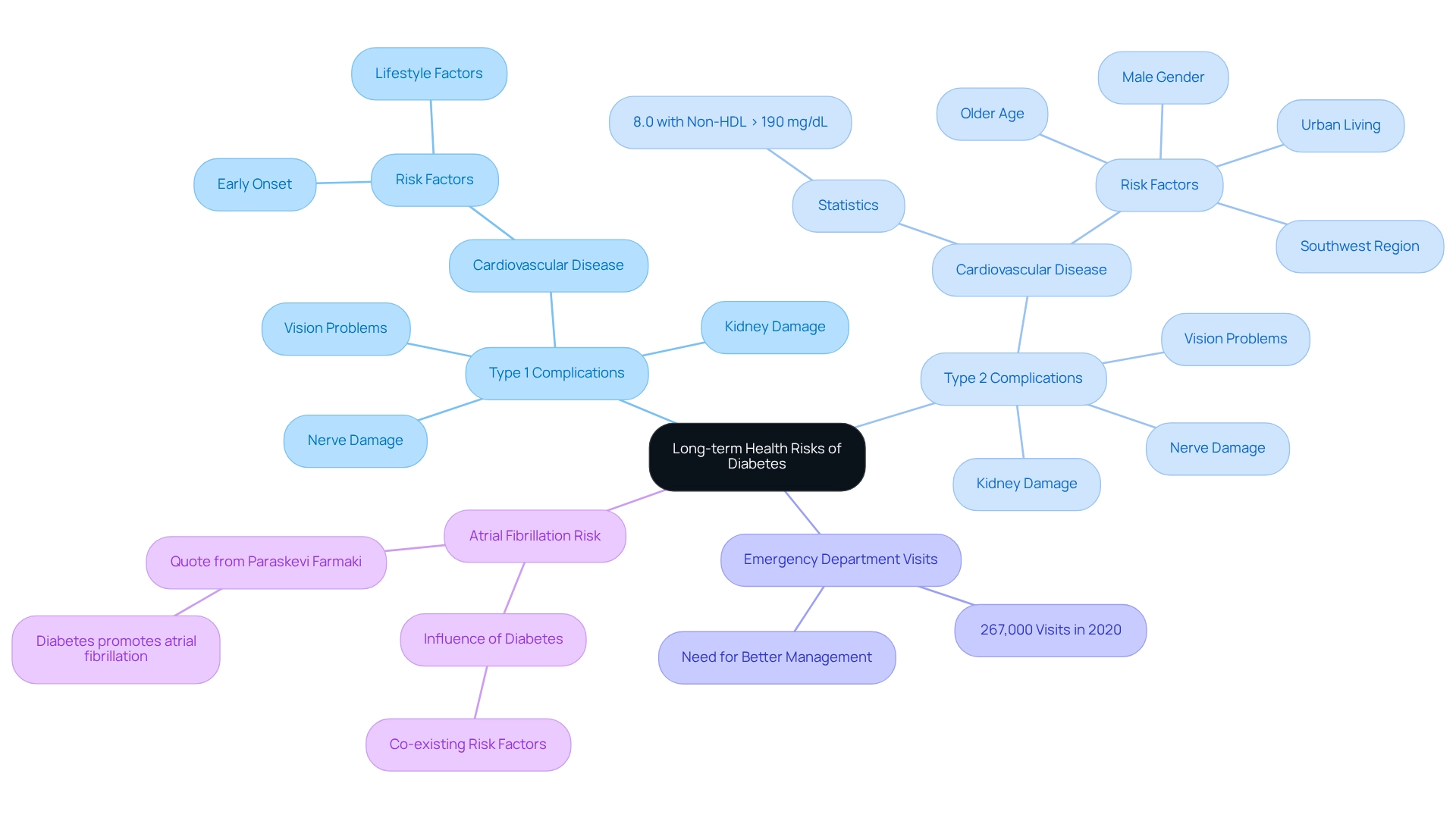
Diagnosis: Distinguishing Type 1 and Type 2 Diabetes through Testing
Identifying this condition involves a series of critical tests, including the A1C test, fasting plasma glucose test, and oral glucose tolerance test. For type 1 & type 2 diabetes, the presence of specific autoantibodies is a key indicator that confirms the diagnosis for type 1, distinguishing it from type 2 diabetes, which is primarily identified through elevated blood glucose levels and the absence of these autoantibodies. It's understandable to feel overwhelmed by recent statistics that emphasize the growing frequency of diabetes-related diagnoses. Medical expenses per individual have increased from $8,417 in 2012 to $9,601 in 2017. This increase underscores the importance of accurate and timely diagnosis, as misdiagnosis or delayed diagnosis can lead to significant financial burdens on both individuals and the healthcare system.
Alongside these tests, comprehending the criteria for Type 2 diagnosis has progressed. Updates indicate the necessity for thorough screening strategies. A significant case study shows that this condition is the primary cause of new blindness instances among adults aged 18–64. In 2019, 11.8% of U.S. adults diagnosed with this condition reported severe vision challenges or blindness. This alarming statistic highlights the necessity for effective management and early detection of the condition. Timely intervention can help prevent such severe complications.
Expert opinions suggest that distinguishing between type 1 & type 2 diabetes through testing is crucial for implementing appropriate treatment plans. As Randy Jackson wisely remarked, "With this condition, there are so many things that you learn that you didn’t think you wanted to know, but now you have this illness, you’ve gotta do it." This emphasizes the significance of comprehending diagnostic techniques not only for immediate care but also for long-term wellness management. Remember, you're not alone in this journey; we are here to support you every step of the way.
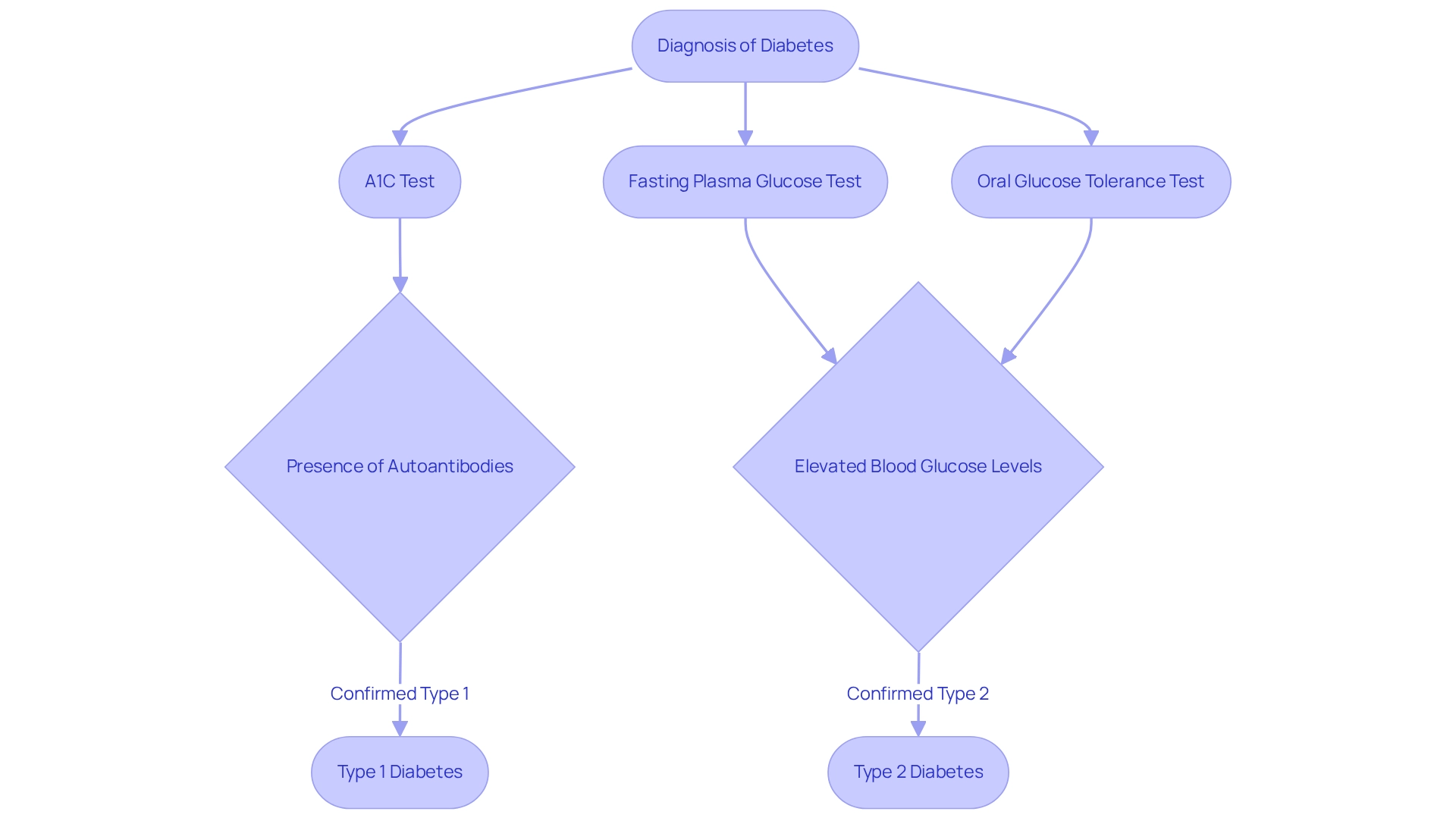
Lifestyle Changes: Dietary and Exercise Recommendations for Type 2 Diabetes
For individuals facing the challenges of type 1 & type 2 diabetes, embracing a healthy lifestyle is not just beneficial—it's essential. Imagine following a balanced diet filled with whole grains, vibrant fruits, fresh vegetables, and lean proteins, all while gently limiting processed foods and sugars. This can feel overwhelming, but you're not alone in this journey.
Consistent physical activity plays a crucial role too. Aim for at least 150 minutes of moderate exercise each week. This commitment can help regulate your blood sugar levels and enhance your overall well-being. Remember, these lifestyle changes can lead to better glycemic control and reduce the risk of complications.
It's understandable to feel uncertain about where to start, but taking these steps can make a significant difference. We are here to support you every step of the way, and together, we can navigate this path toward better health.

Emerging Concepts: Understanding Type 3 Diabetes and Its Connection to Type 1 and Type 2
Emerging Concepts: Understanding Type 3 and Its Connection to Type 1 & Type 2 Diabetes
Type 3 is an increasingly recognized term that describes the intricate link between this condition and Alzheimer's disease, particularly in relation to type 1 & type 2 diabetes. It posits that insulin resistance in the brain may play a significant role in cognitive decline. This emerging concept underscores the necessity of managing blood sugar levels not only for physical health but also for preserving cognitive function. Recent studies suggest that insulin resistance in the brain can worsen cognitive decline. This emphasizes the significance of a comprehensive strategy for managing the condition.
For example, a case study concentrated on enhancing clinical advancements showed a twofold enhancement in forecasting rapid progression to diabetic nephropathy. This finding is vital for understanding complications linked to type 1 & type 2 diabetes. It highlights the necessity for continuous research and education in this field, as it can lead to improved strategies for managing both the condition and its cognitive implications.
At T2DSolutions, we are here to support you as you navigate the complexities of Type 3 diabetes. By promoting understanding of this condition, healthcare providers can better assist you in managing your well-being. If you are recently diagnosed, we encourage you to discuss cognitive well-being with your healthcare providers. Utilize the educational resources available through T2DSolutions to enhance your understanding and management of your condition.
As Sir Prof. Cato T. Laurencin noted, addressing today’s medical challenges requires innovative approaches. Understanding the connection between cognitive health and type 1 & type 2 diabetes is a vital part of this effort. Remember, you’re not alone in this journey. We are here to support you every step of the way.
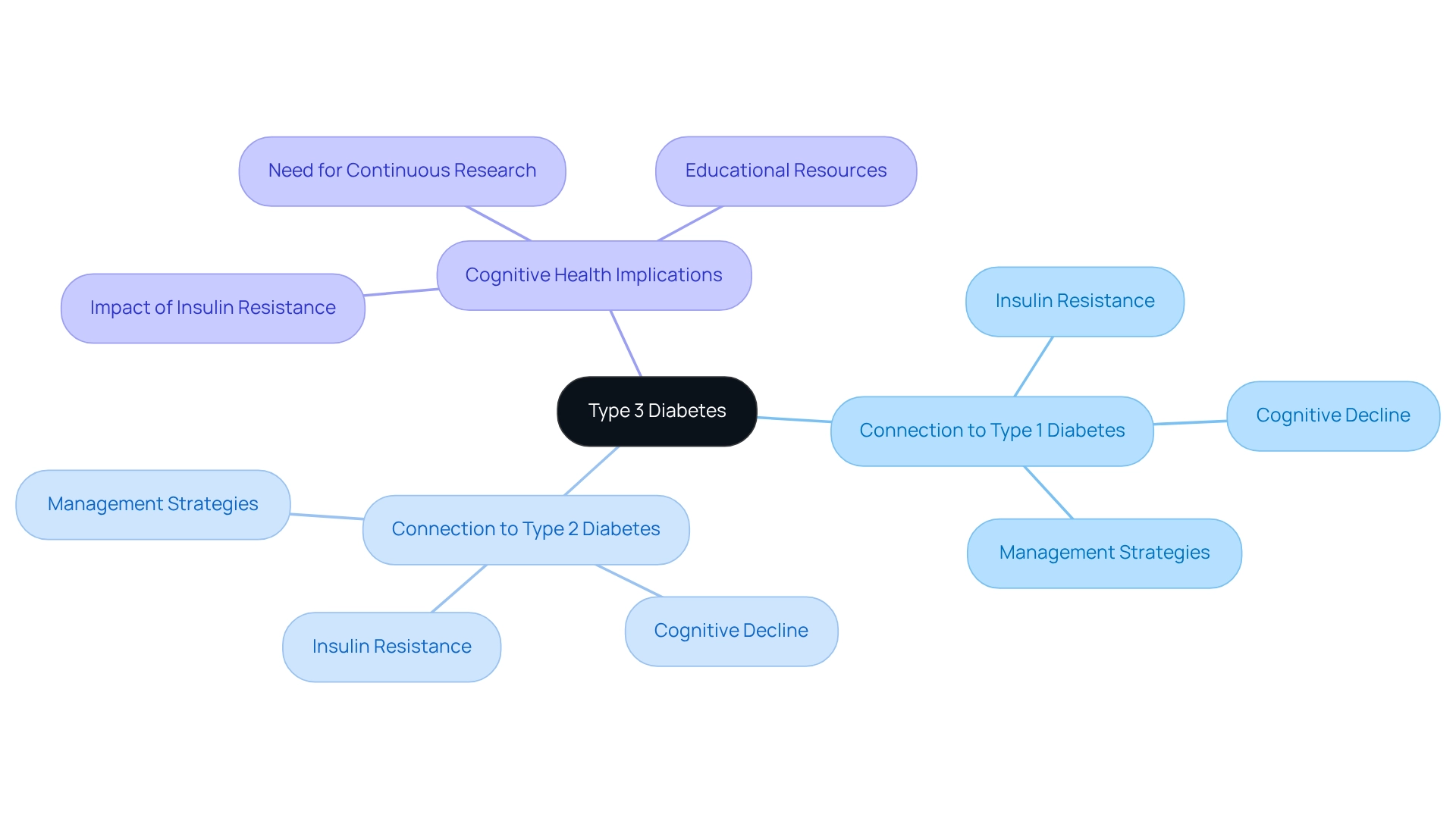
Conclusion
Navigating the complexities of Type 2 and Type 3 diabetes can feel overwhelming, but at T2DSolutions, we are here to empower you and your family with the resources you need for effective management. Our comprehensive suite of educational materials, dietary plans, and community support is designed to address the unique challenges faced by those affected, especially within Hispanic and Latino communities. This commitment to tailored education is crucial, particularly as diabetes becomes more prevalent and burdensome, highlighting the importance of informed decision-making and proactive health management.
Understanding diabetes—its causes, symptoms, treatment protocols, and emotional impacts—can significantly enhance your ability to manage the condition effectively. The insights shared here illuminate the stark differences between Type 1 and Type 2 diabetes, from their underlying mechanisms to the long-term health risks associated with each. By recognizing these distinctions, you can receive more personalized care and be encouraged to make lifestyle modifications that can improve your overall health outcomes.
Remember, you are not alone on this journey of managing diabetes. T2DSolutions fosters a supportive community where individuals can connect, share experiences, and find comfort in knowing that help is readily available. By leveraging the resources and support we offer, you can navigate your diabetes journey with confidence and resilience. Together, we can reinforce the message that proactive management and education are essential to living a fulfilling life, despite the challenges posed by diabetes.
Frequently Asked Questions
What resources does T2DSolutions offer for managing diabetes?
T2DSolutions provides a wide range of resources including educational materials, organizational strategies, dietary plans, exercise routines, and insights from medical research specifically designed for individuals, families, and healthcare providers managing type 1 and type 2 diabetes.
Why is education important for managing diabetes, particularly in Hispanic and Latino communities?
Education is crucial because the incidence of diabetes among Hispanic and Latino adults ranges from 5.0% to 7.3%. Customized educational materials are necessary to address the specific challenges these communities face in managing blood sugar levels.
How does T2DSolutions collaborate with community organizations?
T2DSolutions actively partners with community-based organizations to enhance outreach and support for individuals affected by diabetes, thereby improving education and prevention efforts related to blood sugar conditions.
What are the financial implications of diabetes in the U.S.?
The total estimated cost of diagnosed diabetes in the U.S. for 2022 reached approximately $412.9 billion, highlighting the importance of effective organizational resources for managing the condition.
What should newly diagnosed patients do to manage their diabetes effectively?
Newly diagnosed patients are encouraged to explore T2DSolutions' comprehensive resources and engage with community support networks to enhance their management journey.
What are the main differences between type 1 and type 2 diabetes?
Type 1 diabetes is primarily triggered by an autoimmune reaction that leads to minimal or no insulin production, while type 2 diabetes is characterized by insulin resistance, where the body's cells do not respond effectively to insulin, often due to factors like obesity and a sedentary lifestyle.
What are common symptoms of type 1 and type 2 diabetes?
Common symptoms include excessive thirst, frequent urination, intense hunger, fatigue, and blurred vision. Type 1 and type 2 diabetes may also present slow-healing sores, frequent infections, and areas of darkened skin.
Why is early identification of diabetes symptoms important?
Early identification is crucial for timely medical intervention, as around 3.4 million fatalities were linked to diabetes, and the medical costs for individuals with diabetes are significantly higher than for those without the condition.
How does T2DSolutions support individuals in managing their diabetes?
T2DSolutions serves as a vital resource center, offering education and support to newly diagnosed patients to help them navigate their health condition effectively and encourages them to seek resources and community support.



